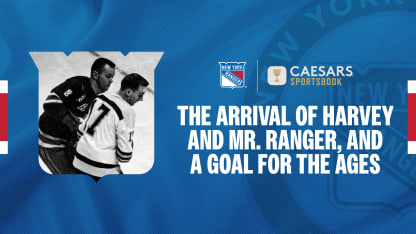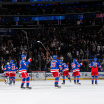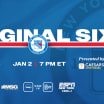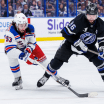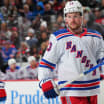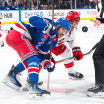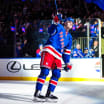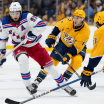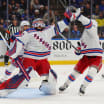In nearly a century of New York Rangers hockey, there is no opponent that the team has played more times than the Boston Bruins. And at times in their respective histories, the paths of the Blueshirts and Bruins were on similar trajectories, through both highs and lows.
In each of the Rangers’ first three years of existence from 1926-27 through 1928-29, they faced the Bruins in the playoffs; New York defeated Boston in the Semifinals in 1928 on its run to the first Stanley Cup in franchise history, while in 1929, the Bruins defeated the Rangers in the Stanley Cup Final to capture their first Stanley Cup. Over a three-year period from 1938-39 through 1940-41, either the Rangers or Bruins won the Stanley Cup; after the Blueshirts were defeated by Boston in an epic, seven-game series in the 1939 Semifinals, they returned the favor by beating the Bruins in six games during the 1940 Semifinals.
And in the early-1970s, the Rangers and Bruins were among the best teams in the NHL, and the rivals battled in three playoff series over a four-year span. Before they reached those heights, both franchises went through lean years simultaneously for the first early part of the 1960s.
For the Rangers, however, one exception was the 1961-62 season, when their dominance of the Bruins led to a playoff appearance and a memorable campaign for players and fans alike.
The Rangers entered that season with tremendous excitement, thanks to the arrival of one of the NHL’s most legendary defensemen. On May 31, 1961, Doug Harvey was named as player-coach with the Rangers. After a long negotiation between the Blueshirts and Montreal Canadiens, Harvey agreed to sign a three-year contract with the team to be its player-coach, and as compensation for signing Harvey, the Rangers agreed to trade Lou Fontinato, their fan-favorite defenseman, to Montreal.
On the day he was introduced, Harvey – who had won the Norris Trophy as the NHL’s Best Defenseman in six of the previous seven seasons – said, “I intend to play a full schedule as well as coach. I believe I played 40 minutes of each game last year except a couple of times when I was hurt and I expect to do as much next season.”
The Rangers began the 1961-62 season with a back-to-back, home-and-home set against the Bruins. In the season opener on October 11, 1961 in Boston, New York scored six unanswered goals – including four in a span of 6:35 in the second period – in a 6-2 victory over the Bruins. The following night, the Rangers defeated the Bruins, 6-3, and Andy Bathgate – the Blueshirts’ star right winger who had been named captain prior to the start of the season – tallied a hat trick, much to the delight of the boisterous crowd.
The back-to-back wins over the Bruins put the Rangers on the right track for a strong start to the season. In their 20th game of the season – which took place on Thanksgiving on November 23, 1961 against the Bruins in Boston – the Blueshirts rallied from a 3-1 deficit to defeat the Bruins, 4-3, as Harvey scored the game-winning goal with 18 seconds remaining in regulation. New York’s stunning comeback victory in Boston capped off a three-game winning streak and seven-game point streak for the Rangers, and with a 10-5-5 record through their first 20 games, they were sitting atop the NHL standings.
Harvey – both on the ice and behind the bench – was making an impact that far exceeded what the Rangers had anticipated. Through the first 20 games of the schedule, Bathgate tallied a league-best 32 points and 22 assists. In addition, center Earl Ingarfield had 11 goals and 10 assists in those 20 contests. When the polling was done for the NHL’s major awards at the end of the first half of the season, Harvey was the leading vote-getter for not only the Norris Trophy, but also for the Hart Trophy as the NHL’s Most Valuable Player.
The Rangers, however, had a difficult start to the second half of the year, and by the end of January, they were battling with the Detroit Red Wings for the fourth and final playoff spot in the NHL standings. Just as they had used back-to-back wins against Boston to start the season on the right foot, the Blueshirts did the same thing to help stabilize their season, defeating the Bruins in consecutive days; first, a 5-0 shutout victory at MSG on January 31, 1962 and then a 5-3 win in Boston on February 1, 1962.
In March, two key games between the Rangers and Red Wings helped determine the fate of the Blueshirts’ season. Entering a contest between the two teams on March 6 at the Detroit Olympia, the Rangers held a one-point lead over the Red Wings with seven games remaining in the season, but the Red Wings had three games in hand. Detroit held a 4-2 lead in the third period, but the Rangers responded with three unanswered goals to rally and stun the Red Wings, 5-4.
Then, on March 14, 1962, the Rangers played Detroit at MSG in a game that turned into one of the most memorable contests in franchise history. The Blueshirts and Red Wings entered the game tied for fourth place with 57 points, although Detroit had one game in hand; including the game on March 14, the Rangers had five games remaining in the season and the Red Wings had six games remaining.
Bathgate opened the scoring to put the Rangers ahead, but Detroit tied the game before the end of the first period and then took a 2-1 lead in the second period when Gordie Howe scored his 500th career NHL goal. The Rangers fans at MSG gave Howe a standing ovation, recognizing his milestone goal, but they also realized that the goal could be damaging to the team’s playoff hopes. Fortunately for ‘The Garden Faithful’, Ingarfield tallied a power play goal less than a minute after Howe’s goal to tie the game.
The game reached its apex midway through the third period when left wing Dean Prentice, had a chance to give the Rangers the lead on a breakaway. Detroit’s goaltender Hank Bassen threw his stick in attempting to stop Prentice, which resulted in referee Eddie Powers awarding a penalty shot to the Rangers. But instead of awarding the shot to Prentice, Powers said that Bathgate would take the penalty shot.
Despite Detroit’s arguments, Bathgate skated to center ice. With potentially the game – and as a result of the shot, the fate of the season – on his stick, Bathgate skated towards the net, faked a shot on his forehand to get Bassen moving to one side, and then skated around him and slipped the puck on his backhand into the yawning net.
As hockey historian Stan Fischler described it, “Bathgate’s fake on Bassen was so good that if there weren’t boards around the rink, Bassen would have ended up in the Hudson River. It was the absolute perfect, dramatic move.”
The Rangers held on to defeat Detroit in the contest. In their second-to-last game of the season, the Blueshirts all but secured a playoff berth by defeating the Bruins, 4-3, in Boston. The win gave the Rangers a 10-2-2 record in 14 contests against the Bruins in 1961-62; to this day, the 10 wins against the Bruins that campaign are tied for the most they Rangers have earned against a single opponent in one season in franchise history.
Harvey won the Norris Trophy and was the runner-up for the Hart Trophy. Bathgate was named to the NHL’s First All-Star Team, as he led the NHL with 56 assists and tied for the NHL lead with 84 points (Bobby Hull won the Art Ross Trophy by virtue of scoring more goals than Bathgate).
The Blueshirts faced the Maple Leafs in the playoff Semifinals. The first two games of the series took place in Toronto, and the Maple Leafs emerged victorious in two close, hard-fought contests to take a two-games-to-none lead in the series.
Returning to MSG for Games 3 and 4, Harvey made changes to the Rangers’ lineup – some out of necessity, others in an attempt to infuse more speed. Right wing Ken Schinkel, who had played nearly every game for the Rangers in 1961-62, suffered a broken right toe and would be sidelined for the remainder of the series. Left wing Vic Hadfield, who played in 44 games during the regular season, was inserted into the lineup for Game 3. So too was 20-year-old right wing Rod Gilbert, who had only played in one regular season game during the season and was the player the Rangers called up to replace Schinkel on the roster.
Gilbert dressed for Game 3, playing on a line with Dave Balon (a rookie) and Johnny Wilson (a veteran with over 600 games of NHL experience), and the trio led the way for the Rangers. Toronto opened the scoring and had a 2-1 lead in the second period, but Wilson scored two goals before the end of the period to give the Rangers a 3-2 lead. In the third period, Toronto’s Red Kelly tied the game with a power play goal, but just 15 seconds later, Andy Hebenton scored a power play goal of his own to put the Rangers ahead. Just over three minutes later, Balon added an insurance goal – with the assists going to Wilson and Gilbert. The Rangers held on for a 5-4 win and got back into the series.
Game 4 marked the start of a love affair between Gilbert and ‘The Garden Faithful’. He opened the scoring 41 seconds into the game and then added a second goal late in the first period to give the Rangers a 2-0 lead and send the MSG crowd into a frenzy. The Maple Leafs got on the board with 8:01 remaining in regulation, but just over two minutes later, Balon scored a goal – on a play set up by Gilbert – to help the Rangers regain a two-goal lead. Behind three points from Gilbert and 40 saves from goaltender Gump Worsley, the Blueshirts tied the series at two games apiece with a 4-2 victory.
The Blueshirts traveled to Toronto for Game 5 without one of their best players. Dean Prentice had missed Game 4 due to a knee injury and it was not progressing well enough to enable him to return to the series. Hadfield had stepped into Prentice’s spot on a line with Ingarfield and Bathgate and had performed admirably in that role in Game 4. The rookies – Balon, Gilbert, and Hadfield – were leading the charge as the Rangers aimed to take the lead in the series.
In Game 5, Worsley gave the Rangers every chance to win. Although Toronto scored a goal in the first period and the second period to take a 2-0 lead, the goaltender kept the Rangers in the contest with several spectacular saves from point blank range. The Blueshirts rallied to score two goals and tie the game, sending the game into overtime.
On this night, one overtime would not be enough to decide a winner, as Worsley and Maple Leafs goaltender Johnny Bower stopped every shot that was sent their way in the first extra session. Just over four minutes into the second overtime, Worsley – after making an initial save – was lying flat on his back in the goal crease, believing that the puck was underneath him. According to referee Eddie Powers, the puck was visible underneath Worsley’s arm and shoulder. When the Rangers’ goalie moved to see where the puck was after he didn’t hear a whistle, his movement made the puck more visible to Powers and the other players on the ice. While players on both teams waited for a whistle, Maple Leafs center Red Kelly spotted the puck, retrieved it from underneath Worsley, and put it into the net to give Toronto a 3-2 win and a three-games-to-two lead in the series.
The loss stunned the Rangers, especially Worsley, who made 56 saves in what was one of the best performances of his career. Red Burnett, a Hall of Fame journalist for the Toronto Star, wrote that “This writer never has seen better playoff goalkeeping than Worsley threw at (the) Leafs.” In the midst of Toronto’s celebration, Bower skated towards Worsley, rather than his own team’s celebration, to congratulate him on his performance. Worsley – who temporarily lost his job as the Rangers’ starting goalie to Bower for the 1953-54 season – was equally as complimentary in his response to Bower.
“I couldn’t see the puck and I don’t know whether Powers saw it or not,” Harvey said after the game. “Powers told me he saw some of it. But the rules say the entire puck must be in view for play to continue. Of course, it wouldn’t do any good to argue.”
Carrying the momentum they had from the win in Game 5, the Maple Leafs started strong against the Rangers in Game 6 in Toronto, scoring the first three goals of the game in the first period. The Rangers lost the game, 7-1, and their season was over.
“It’s too bad,” Harvey said following Game 6. “It’s too bad it had to end this way. I was just thinking about the boys and I was thinking that I know they gave me their best, everything they had.”
As Harvey said, the Rangers had given their best, not only in the series with the Maple Leafs, but throughout the 1961-62 season. The result was one of the most memorable campaigns in Blueshirts history.

